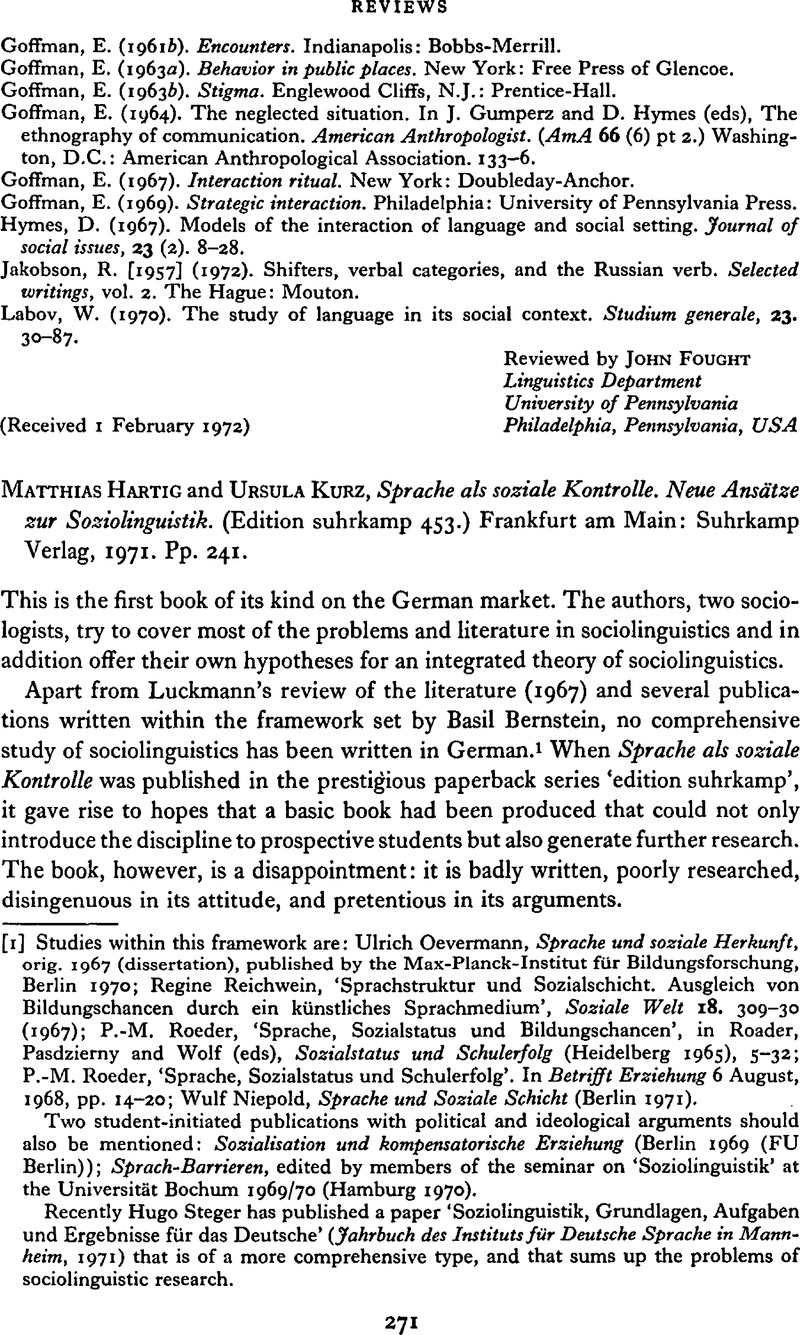No CrossRef data available.
Article contents
Matthias Hartig and Ursula Kurz, Sprache als soziale Kontrolle. Neue Ansätze zur Soziolinguistik. (Edition suhrkamp 453.) Frankfurt am Main: Suhrkamp Verlag, 1971. Pp. 241.
Published online by Cambridge University Press: 18 December 2008
Abstract

- Type
- Book Review
- Information
- Copyright
- Copyright © Cambridge University Press 1972
References
[1] Studies within this framework are: Oevermann, Ulrich, Sprache und soziale Herkunft, orig. 1967 (dissertation), published by the Max-Planck-Institut für Bildungsforschung, Berlin 1970Google Scholar; Reichwein, Regine, ‘Sprachstruktur und Sozialschicht. Ausgleich von Bildungschancen durch ein künstliches Sprachmedium’, Soziale Welt 18. 309–30 (1967)Google Scholar; Roeder, P.-M., ‘Sprache, Sozialstatus und Bildungschancen’, in Roader, Pasdzierny, and Wolf, (eds), Sozialstatus und Schulerfolg (Heidelberg 1965), 5–32Google Scholar; Roeder, P.-M., ‘Sprache, Sozialstatus und Schulerfolg’. In Betrifft Erziehung 6 08, 1968, pp. 14–20; Wulf Niepold, Sprache und Soziale Schicht (Berlin 1971).Google Scholar
Two student-initiated publications with political and ideological arguments should also be mentioned: Sozialisation und kompensatorische Erziehung (Berlin 1969 (FU Berlin)); Sprach-Barrieren, edited by members of the seminar on ‘Soziolinguistik’ at the Universität Bochum 1969/70 (Hamburg 1970).
Recently Hugo Steger has published a paper ‘Soziolinguistik, Grundlagen, Aufgaben und Ergebnisse für das Deutsche’ (Jahrbuch des Instituts für Deutsche Sprache in Mannheim, 1971) that is of a more comprehensive type, and that sums up the problems of sociolinguistic research.
[2] ‘The authors are often easily satisfied, being full of discovery joy, with simply listing areas within social structure where social action is very much influenced by language’ (26). The reviewer has translated all his quotations, but these translations are kept very closely to the German sentence – and – word-structure.
[3] E.g. ‘Introduction: toward ethnographies of communication’ (1964); ‘Two types of linguistic relativity’ (1966); ‘Models of the interaction of language and social setting’ (1967); ‘On communicative competence’ (1967); all of which were available to the authors before they closed their preface in August 1970.
[4] Misprints often involve bibliographic notes, e.g. ‘Whorf had already in 1952 …’ when Whorf had died in 1941. Furthermore, bibliographic notes in the text only give the name of the author and the date of the publication with no page reference, thus leaving the reader stranded – in case he would like to check.
[5] A very nice ‘mis-hit’ is a translation from Greenberg's Universals of Language (1963: xix): Harig/Kurz write on 96f.: ‘Every language for example has a vowel system that consists of 10 to 70 vowels.’ Whereas Greenberg had written: ‘…that for all languages the number of phonemes is not fewer than 10 or more than 70, or that every language has at least two vowels’.
[6] The use of the word ‘theory’ by the authors is really startling; they do not seem to have a single term ‘theory’. One can easily find hypothesis = theory (56), also model = theory.
[7] This will be done by quoting extensively.
[8] Cf. also 111 , 127, 129.
[9] These factors are: speaker, hearer, channel, information, and code and the functions of language behavior. (This framework should be compared to Hymes's 1962 list which contains seven factors: sender, receiver, message form, channel, code, topic, and setting.) A description of the different types of communication (146–62) is simply a list of the factors in different relationship to each other, one or more being the variables while all others are kept constant.
[10] Here the authors used Osgood, Ch. E./Sebeok, T. A. (eds), Psycholinguistics (Bloomington and London; Indiana University Press, 1965).Google ScholarPubMed
[11] This is really true: ‘system’ is used 18 times on 164 and still 10 times on 167.
[12] Noam Chomsky's Aspects of the Theory of Syntax (1965) shows through the whole




